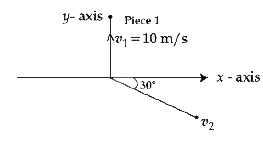Initially a body of mass 10kg is moving along x-axis with velocity 10√3 m/s. It collides with another body of mass 20kg and comes to rest. The 20kg mass object disintegrates in 2 parts each of mass 10kg. One part moves along y-axis with velocity 10m/s and another at 30 degrees with x-axis. Evaluate velocity of object which moves at angle 30 degrees with x-axis
The correct Answer is:20
To solve the problem step by step, we will apply the principle of conservation of momentum.
Step 1: Understand the initial conditions
Initially, we have:
- Mass of the first body, m1=10kg
- Initial velocity of the first body, v1=10√3m/s (along the x-axis)
- Mass of the second body, m2=20kg (initially at rest)
Step 2: Calculate the initial momentum
The initial momentum of the system in the x-direction is given by:
pinitial=m1v1+m2⋅0=10⋅10√3+0=100√3kg m/s
The initial momentum in the y-direction is zero since both bodies are moving along the x-axis.
Step 3: Analyze the collision
After the collision, the first body comes to rest, and the second body (20 kg) disintegrates into two parts of 10 kg each:
1. One part moves along the y-axis with a velocity of 10m/s (let's call this body A).
2. The other part moves at an angle of 30∘ with the x-axis (let's call this body B).
Step 4: Write down the final momentum equations
For the y-direction:
- The momentum of body A (moving upwards) is pA=10⋅10=100kg m/s.
- The momentum of body B (moving downwards) is pB=10v′sin(30∘)=10v′⋅12=5v′.
Since the initial momentum in the y-direction was zero, the final momentum in the y-direction must also be zero:
pA+pB=0⟹100−5v′=0
Step 5: Solve for v′
Rearranging the equation gives:
5v′=100⟹v′=1005=20m/s
Step 6: Conclusion
The velocity of the object that moves at an angle of 30∘ with the x-axis is 20m/s.
---
Initially, we have:
- Mass of the first body, m1=10kg
- Initial velocity of the first body, v1=10√3m/s (along the x-axis)
- Mass of the second body, m2=20kg (initially at rest)
The initial momentum of the system in the x-direction is given by:
pinitial=m1v1+m2⋅0=10⋅10√3+0=100√3kg m/s
The initial momentum in the y-direction is zero since both bodies are moving along the x-axis.
After the collision, the first body comes to rest, and the second body (20 kg) disintegrates into two parts of 10 kg each:
1. One part moves along the y-axis with a velocity of 10m/s (let's call this body A).
2. The other part moves at an angle of 30∘ with the x-axis (let's call this body B).
For the y-direction:
- The momentum of body A (moving upwards) is pA=10⋅10=100kg m/s.
- The momentum of body B (moving downwards) is pB=10v′sin(30∘)=10v′⋅12=5v′.
pA+pB=0⟹100−5v′=0
Rearranging the equation gives:
5v′=100⟹v′=1005=20m/s
The velocity of the object that moves at an angle of 30∘ with the x-axis is 20m/s.
Topper's Solved these Questions
- BOOK - JEE MAINS PREVIOUS YEARCHAPTER - JEE MAIN 2021EXERCISE - SECTION-A80videos
JEE MAIN 2021
- BOOK - JEE MAINS PREVIOUS YEARCHAPTER - JEE MAIN 2021EXERCISE - SECTION-B40videos
JEE MAIN 2021
- BOOK - JEE MAINS PREVIOUS YEARCHAPTER - JEE MAINEXERCISE - All Questions473videos
JEE MAIN
- BOOK - JEE MAINS PREVIOUS YEARCHAPTER - JEE MAIN 2022EXERCISE - Question492videos
JEE MAIN 2022
Similar Questions
Knowledge Check
- Question 1 - Select One
A body of mass 5 kg moving with a velocity 10 m/s collides with another body of the mass 20 kg at, rest and comes to rest. The velocity of the second body due to collision is
A2.5 m/sB5m/sC7.5 m/sD10 m/s - Question 2 - Select One
A body of mass 5 kg moving with a velocity 10 m/s collides with another body of the mass 20 kg at rest, and comes to rest. The velocity of the second body due to collision is
A2.5 m/sB5 m/sC7.5 m/sD10 m/s - Question 3 - Select One
A body of mass 1kg is moving along a straight line with a velocity of 1m/s. The external force acting in the body is
A1NB1 dyneC1JDzero
A ball of mass 10 kg moving with a velocity 10√3m/s along the x-axis, hits another ball of mass 20 kg which is at rest. After the collision, first ball comes to rest while the second ball disintegrates into two equal pieces. One piece starts moving along y-axis with a speed of 10 m/s. The second piece starts moving at an angle of 30 with respect to the x-axis. The velocity of the ball moving at 30∘ with X-axis is x m/s. The configuration of pieces after collision is shown in the figure below.
The value of x to the nearest integer is ______
 View Solution
View SolutionA body of mass 4kg moving with velocity 12m/s collides with another body of mass 6kg at rest. If two bodies stick together after collision , then the loss of kinetic energy of system is
View SolutionA body of mass M moves with velocity v and collides elasticity with another body of mass m(M>>m) at rest , then the velocity of the body of mass m is
View SolutionA body of mass 1 kg moving with velocity 5 m/s collides with another body of mass 2 kg moving with velocity 1.5 m/s in opposite direction. If the coefficient of restitution is 0.8, their velocities aftter collision respectively are
View SolutionA body of mass m moving with a velocity v in the x direction collides with another body of mass M moving in y direction with a velocity V. They coalesce into one body during collision.
View Solution

